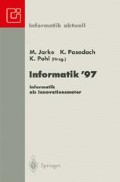Zusammenfassung
Fuzzy-Systeme, künstliche Neuronale Netzwerke und Evolutionäres Rechnen — im folgenden unter dem Begriff CI-Methoden (CI = Computational Intelligence) subsumiert — haben, grob betrachtet, vieles gemeinsam:
-
Ihre Grundkonzepte sind seit langem bekannt und waren zeitweise umstritten. Ein Grund für die anfänglich zögerliche Akzeptanz bestand unter anderem in der Nichtverfügbarkeit ausreichender Rechenleistung. Außerdem galt es, Widerstande in etablierten Disziplinen zu überwinden. Und, wie in anderen Forschungsfeldern auch, mußte sich zunächst eine „kritische Masse“ bilden, welche die Initialzündung für eine breite Forschung auslöste.
-
Sie werden zunehmend erfolgreich und immer breiter angewandt. Analog zu vielen anderen Wissenschaftszweigen entstand auch auf dem Gebiet der CI die kritische Masse im Bereich der Anwendungsforschung. Konkrete, praktische Probleme existieren und müssen gelöst werden, unabhängig davon, ob die Grundlagenforschung dies wahrnimmt oder nicht, vielleicht sogar die generelle Unlösbarkeit unter gewissen Prämissen zeigt. Neue Methoden werden oft zunächst versuchsweise angewandt und erweisen sich gegebenenfalls in der Praxis als nützlich, ohne daß der formale Nachweis der Anwendbarkeit a priori geführt wurde. Die Existenzberechtigung der Methoden lautet: „Es funktioniert“. Das ist dann Stimulans für die Suche nach dem „Warum?“bzw. „Wann und wann nicht?“.
Access this chapter
Tax calculation will be finalised at checkout
Purchases are for personal use only
Preview
Unable to display preview. Download preview PDF.
Literatur
D. C. Dennett.Darwin’s Dangerous Idea. Simon & Schuster, New York, 1995.
H.-P. Schwefel. Parallel problem solving from nature. In A. Kent, J. G. Williams, and C. M. Hall, Hrsg.,Encyclopedia of Computer Science and Technology. Marcel Dekker, New York, 1997, (im Druck).
E. Fiesler and R. Beale, Hrsg.Handbook of Neural Computation. Oxford University Press, New York, 1996.
E. Ruspini, P. Bonissone, and W. Pedrycz, Hrsg.Handbook of Fuzzy Computation. Oxford University Press, New York, 1997 (im Druck).
Th. Bäck, D. B. Fogel, and Z. Michalewicz, Hrsg.Handbook of Evolutionary Computation. Oxford University Press, New York, 1997.
J. M. Zurada, R. J. Marks II, and C. J. Robinson, Hrsg.Computational Intelligence: Imitating Life. IEEE Press, New York, 1994.
J. C. Bezdek. What is Computational Intelligence? In Zurada et al. [6], Seiten 1–12.
J. C. Bezdek. Computational Intelligence and Edge Detection. In A. Grauel, Hrsg., Proc. Fuzzy-Neuro-Systems’97— Computational Intelligence, Seiten 1-31. infix-Verlag, Sankt Augustin, 1997.
F. Rosenblatt. The Perceptron: A Probabilistic Model for Information Storage and Organization in the Brain.Psychological Review, 65 (6): 386–408, 1958.
J. H. Holland. Outline for a logical theory of adaptive systems. J.of the ACM, 3:297–314, 1962.
J. H. Holland. Adaptation in Natural and Artificial Systems. The Univ. of Michigan Press, Ann Arbor, MI, 1975.
L. J. Fogel. Autonomous automata.Industrial Research, 4:14–19, 1962.
L. J. Fogel, A. J. Owens, and M. J. Walsh.Artificial Intelligence through Simulated Evolution. Wiley, New York, 1966.
I. Rechenberg. Cybernetic solution path of an experimental problem. Royal Aircraft Establishment, Library translation No. 1122, Farnborough, Hants., UK, August 1965.
I. Rechenberg.Evolutionsstrategie: Optimierung technischer Systeme nach Prinzipien der biologischen Evolution. Dissertation, TU Berlin, 1971.
H.-P. Schwefel. Experimentelle Optimierung einer Zweiphasenduse. Interner Bericht HE/F 35-B, AEG Forschungsinstitut, Berlin, Oktober 1968.
H.-P. Schwefel. Evolutionsstrategie und numerische Optimierung. Dissertation, TU Berlin, Mai 1975.
L. A. Zadeh. Fuzzy sets.Information and Control, 8:338–353, 1965.
M. Minsky and S. Papert.Perceptrons. MITPress, Cambridge, MA, 1969.
F. Hayes-Roth, D. A. Waterman, and D. B. Lenat, Hrsg.Building Expert Systems. Addison-Wesley, Reading, MA, 1983.
R.K. Lindsay, B.G. Buchanan, E.A. Feigenbaum, and J. Lederberg.Applications of Artificial Intelligence for Organic Chemistry: The DENDRAL Project. McGrawHill, New York, 1980.
B.G. Buchanan and E.H. Shortcliff.Rule Based Expert Systems: The MYCIN Experiments of the Stanford Heuristic Programming Project. Addison-Wesley, Reading, MA, 1985.
J. J. Hopfield. Neural networks and physical systems with emergent collective computational abilities.Proc. National Academy of Science, 79:2554–2558, 1982. .
D.E Rumelhart und J.L McClelland.Parallel Distributed Processing — Explorations in the Microstructure of Cognition, Band 1: Foundations. MIT Press, Cambridge, MA, 1986
T.J. Sejnowski and C. R. Rosenberg. Parallel Networks that Learn to Pronounce English Text.Complex Systems, 1:145–168, 1987.
T. Kohonen, M. Shozakai, J. Kangas, and O. Venta. Microprocessor implementation of a large vocabulary speech recognizer and phonetic typewriter for Finnish and Japanese. In J.A. Laver and M.A. Jack, Hrsg.,Proc. Europ. Conf. on Speech Technology, Seiten 377–380. CEP Consultants, Edinburgh, 1987.
D. E. Goldberg. Genetic algorithms and rule learning in dynamic system control. In J. J. Grefenstette, Hrsg.,Proc. First Int’1 Conf. Genetic Algorithms and Their Applications, Seiten 8–15. Lawrence Erlbaum, Hillsdale, NJ, 1985.
D. E. Goldberg. Genetic Algorithms in Search, Optimization and Machine Learning. Addison-Wesley, Reading, MA, 1989.
D. Hartmann. Optimization in CAD: On the applicability of nonlinear evolutionstrategies for optimization problems in CAD. In J.S. Gero, Hrsg.,Optimization in Computer-Aided Design, Seiten 293–305. Elsevier, Amsterdam, 1985.
L. P. Holmblad and J. J. Ostergaard. Control of a cement kiln by fuzzy logic.FIDP, Seiten 389–399, 1982.
J. T. Alander. An Indexed Bibliography of Genetic Algorithms: Years 1957–1993. Art of CAD Ltd, Espoo, Finnland, 1994.
C. C. Klimaskausas, Hrsg.The 1989 Neuao-Computing Bibliography. MITPress, Cambridge, MA, 1989.
K. Hirota.Industrial Applications of Fuzzy Technology. Springer, Tokyo,1993. 34. M. Sugeno. Industrial Applications of Fuzzy Control. North-Holland, Amsterdam, 1985.
M. Sugeno .Industrial Application of Fuzzy Control. North-Holland, Amsterdam, 1985
M. M. Gupta and T. Yamakawa, Hrsg.Fuzzy Computing: Theory, Hardware and Applications. Elsevier, Amsterdam, 1988.
J. Biethahn and V. Nissen.Evolutionary Algorithms in Management Applications. Springer, Berlin, 1995.
Author information
Authors and Affiliations
Editor information
Editors and Affiliations
Rights and permissions
Copyright information
© 1997 Springer-Verlag Berlin Heidelberg
About this paper
Cite this paper
Schwefel, HP., Hammel, U. (1997). Sonderforschungsbereich 531. In: Jarke, M., Pasedach, K., Pohl, K. (eds) Informatik ’97 Informatik als Innovationsmotor. Informatik aktuell. Springer, Berlin, Heidelberg. https://doi.org/10.1007/978-3-642-60831-5_15
Download citation
DOI: https://doi.org/10.1007/978-3-642-60831-5_15
Publisher Name: Springer, Berlin, Heidelberg
Print ISBN: 978-3-540-63066-1
Online ISBN: 978-3-642-60831-5
eBook Packages: Springer Book Archive

